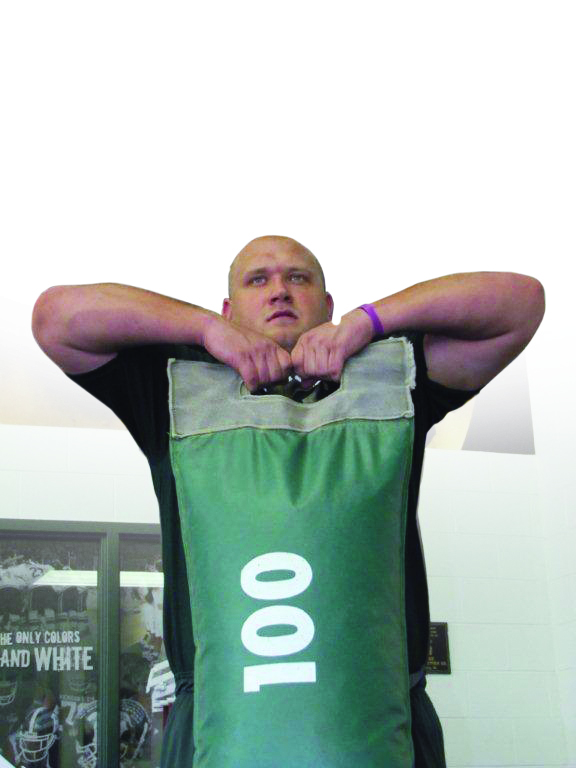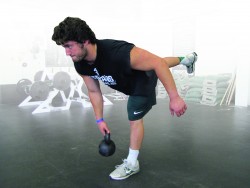Powerline: Increase volume with multiple-set applications
In past Powerline installments, I have discussed the issues, benefits and possible pitfalls of varying set prescriptions per exercise and total volume in a given strength training routine. Many of the inquiries I receive from Coach & Athletic Director readers are on how to develop more variety in their multi-set strength training regimens without crossing the line into a state of overtraining.
 Three consecutive sets of the sandbag high pull are used during the pull emphasis. |
Science and empirical evidence continue to demonstrate there is no real superiority to set applications per exercise. An intensive review of the peer-reviewed literature indicates parallel gains and improvements along an entire spectrum of set protocols ranging from one to three, or more. Many coaches, however, still incorporate multi-set sequences ranging from two to six sets on movements they feel require special attention, or as based upon their training backgrounds and beliefs. Others merely enjoy the physical and mental challenge of performing several sets of the same movement. And, of course, there is a segment of competitive lifters who must perform varied set applications of their targeted movements for skill specificity and neural adaptations.
For the most part, my personal approach is to place effort above volume when constructing strength training routines. And, as I have explained on numerous occasions, we devise many workouts where the same musculature is targeted with one or two sets of two to four different movements to stimulate those areas through different planes (i.e., vertical from low to high, incline, horizontal, and vertical from high to low).I also believe, however, that multi-set applications can be performed effectively — and without fear of overtraining — if certain guidelines are met:
- The high-end volume of the workout stays as close to 20 to 22 total sets as possible. Certainly, fewer total sets can be performed with excellent results, and that component basically is determined by the time allotment and the additional physical stresses placed upon your athletes during the period in question.
- A determination is made on either emphasizing more sets of fewer total exercises, or performing more total exercises with fewer sets of each.
- Accountability for effort and progress are in effect, regardless of the set or exercise emphasis.
I want to provide some ideas on how to design and implement comprehensive, multi-set strength training routines, along with their attached coaching points and suggestions. All of the sets listed are designated as “work sets.” Any warm-up sets executed prior to the work sets are not included in the total volume.
Two-set applications
Two-set applications are extremely useful, beneficial and time efficient, especially during periods like preseason camp. There are several ways for incorporating the two-set scheme, and all of them are very effective:
- Perform back-to-back sets of the same exercise.
- Perform two different exercises for the same basic muscle groups (e.g., a set of supine bench press, followed by a set of incline press).
- Perform two antagonistic movements (i.e., alternating a pressing movement with a pulling movement).
- Upper body only, lower body only and total body cycles can be designed, depending upon the situation, time considerations and other peripheral stresses (i.e., during periods of heavy running or practices).
We have implemented all of the above at one time or another. And we’ve found that mixing and matching them makes for interesting combinations and allows us to incorporate a lot of variety in our workout prescriptions.
Here’s one example of an upper body two-set application, performed with the press/pull methodology:
The weight selections for all exercises are such that the last few reps in the range (in this case, between 10 and 12 reps) require great effort without a concurrent breakdown in technique. At times, a cadence is placed on the rep execution, which includes a one second pause at mid-range, and a three second negative (lowering) phase. Approximately one minute of recovery is taken between the two exercises in each coupling and a two-minute respite is taken before moving to the next two movements.
 The kettlebell military press is just one of many exercises used during the upper body push/pull emphasis. It allows the athlete to highlight certain areas and movements without completely abandoning a stimulus to the opposing muscle groups. |
1. Bench press: 10 to 12 reps, followed by lat pulldown, 10 to 12 reps.
2. Incline press: 10 to 12 reps, followed by dumbbell row, 10 to 12 reps each side.
3. Military or push press: 10 to 12 reps, followed by machine horizontal row, 10 to 12 reps.
4. Parallel Dips: Maximal reps possible, followed by chin-ups, maximal reps possible. (Note: At times, our athletes wear weight vests for these two exercises.)
After the set of chin-ups is completed, a longer respite of about three minutes is taken, and then the entire sequence is repeated starting with the bench press/lat pulldown coupling. The difference in the second cycle of the couplings is that the rep range is reduced to eight to 10. You will find that the weight loads for the second cycle are the same, or very close, to the first cycle. This is the result of the cumulative fatigue incurred through the process.
In the end, you have a very effective, 16-set upper body workout, which proves its worth during preseason camp periods and other limited-time scenarios.
One way to incorporate a low dosage of lower extremity work is to add a leg press (or another multi-joint leg/hip movement) and leg curl (or any other hamstring emphasis movement) coupling at the beginning of the first cycle, and then again at the end of the second cycle. This adds four additional sets to the routine for a 20-set total.
Three-set applications
One of our more popular three-set applications is the concept of “descending pyramids.” Each exercise pyramid targets a specific muscle grouping with three all-out sets that descend in reps and, due to the effort put forth, usually require a slight reduction in weight. Unlike an “ascending” pyramid (a system we also use on occasion), which allows for an increase in weight with each set, the metabolic demands and cumulative fatigue of a descending pyramid often require a reduction, or at best, maintenance of the previous weight.
 The Single-Leg Romanian Dead Lift is part of an 18-set schematic, which targets all major musculature of the legs, hips and even the lower back. |
The following is an example of a traditional, lower-body-only descending pyramid:
- Squat (front or back): Three consecutive sets, 10/eight/six.
- Glute-ham raises: Three consecutive sets, 10/eight/six.
- Leg press: Three consecutive sets, 10/eight/six.
- Leg curl: Three consecutive sets, 10/eight/six.
- Forward lunges: Three consecutive sets (with either dumbbells or weighted vest), 10/eight/six (Note: Rep assignments are for each leg).
- Single-leg Romanian dead lift (RDL): Three consecutive sets, 10/eight/six (Note: Rep assignments are for each leg). The mid-range position for a single-leg RDL with a kettlebell is shown in the photo.
This 18-set schematic targets all the major musculature of the legs, hips, and to a certain extent, the lower back. Two to three minutes of recovery are allotted between each set of a pyramid and at least a three-minute respite is given between pyramids.
Anterior/posterior coupling
A variation of the traditional, consecutive-set pyramid, involves an anterior/posterior coupling. In other words, a set of a movement that primarily targets the anterior leg musculature is performed first, followed by an exercise emphasizing the posterior leg/hip musculature.
The sequence is repeated until the three pyramid sets are completed in an alternating fashion.
The routine above is altered to look like this:
- Squat: 10 reps, followed by glute-ham raises, 10 reps.
- Squat: Eight reps, followed by glute-ham raises, eight reps.
- Squat: Six reps, followed by glute-ham raises, six reps.
- Leg press: 10 reps, followed by leg curl, 10 reps.
- Leg press: Eight reps, followed by leg curl, eight reps.
- Leg press: Six reps, followed by leg curl, six reps.
- Forward lunges: 10 reps each leg, followed by single-leg RDL’s, 10 reps each leg.
- Forward lunges: Eight reps each leg, followed by single-leg RDL’s, eight reps each leg.
- Forward lunges: Six reps each leg, followed by single-leg RDL’s, six reps each leg.
Recovery between exercises with a coupling can range from one to two minutes and from two to three minutes before proceeding to the next coupling in the sequence.
Upper body press/pull emphasis
For the upper body, we utilize a mixture of combinations coalescing well with our philosophy of incorporating as much variety as possible. In keeping with the descending pyramid theme, let’s examine an approach we implement known as the “press/pull emphasis.”
The first order of business is to determine whether to target the primary pressing muscles (i.e., basically the anterior shoulder region, chest and triceps) or the primary pulling muscles (i.e., basically the posterior shoulder region, upper back and biceps) of the upper torso. From there, it is merely a matter of placing the movements in an orderly sequence.
Normally, we choose three exercises for the descending pyramid, determine the order of execution and insert one set of an antagonist movement after each to provide some work for the opposing muscle groups.
For example, if we want to target the pressing muscles, the descending pyramid could be constructed in the following manner:
- Bench press: Three consecutive sets, 10/eight/six.
- Dumbbell row: Eight reps each side.
- Incline press: Three consecutive sets, 10/eight/six.
- Lat pulldown: Eight reps.
- Push press: Three consecutive sets, 10/eight/six.
- Seated row or chin-ups: Eight reps. This press emphasis routine calls for 12 total sets and can prove to be beneficial when time is tight. A caveat, however, is that the next workout within the same week should be a pull emphasis to achieve some semblance of muscle group balance.
A pull emphasis looks something like this:
- Power pull/high pull: Three consecutive sets, 10/eight/six.
- Dumbbell bench press: Eight reps.
- Lat pulldown: Three consecutive sets of 10/eight/six.
- Kettlebell military press: Eight reps.
- Dumbbell row: Three consecutive sets for each side, 10/eight/six.
- Dumbbell incline press: Eight reps. This multi-set application enables you to highlight certain areas and movements without completely abandoning a stimulus to the opposing muscle groups. The specific exercises and equipment used are a matter of personal choice; we recommend as much variety in both as possible.
Final rep
For the sake of accountability, record these workouts, especially if you plan to use them in workout rotations on a regular basis.
Once the high end of the range or target is met in a particular set for two to three weeks, an increment of two and a half to five pounds should be made for the next training session with that specific routine.
Ken Mannie is the head strength and conditioning coach Michigan State University. His column, Powerline, appears regularly in Coach & Athletic Director magazine.


